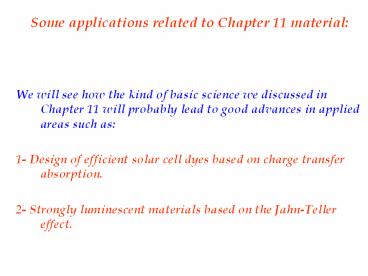Some applications related to Chapter 11 material: - PowerPoint PPT Presentation
Title:
Some applications related to Chapter 11 material:
Description:
Some applications related to Chapter 11 material: We will see how the kind of basic science we discussed in Chapter 11 will probably lead to good advances in applied ... – PowerPoint PPT presentation
Number of Views:93
Avg rating:3.0/5.0
Title: Some applications related to Chapter 11 material:
1
- Some applications related to Chapter 11 material
- We will see how the kind of basic science we
discussed in Chapter 11 will probably lead to
good advances in applied areas such as - 1- Design of efficient solar cell dyes based on
charge transfer absorption. - 2- Strongly luminescent materials based on the
Jahn-Teller effect.
2
1- Design of efficient solar cell dyes based on
charge transfer absorption
3
diimine
dithiolate
These complexes should have charge transfer from
metal or ligand orbitals to the p orbitals.
4
CT-band for Pt(dbbpy)tdt
Data from Cummings, S. D. Eisenberg, R. J. Am.
Chem. Soc. 1996, 118 1949-1960
5
X- Chloride
X-thiolate
dx2-y2
?bpy
hv
CT to diimine
? (thiolate) d ? (Pt)
dxy
dxz-yz
dxz-yz
dz2
Connick W. B. Fleeman, W. L. Comments on
Inorganic Chemistry, 2002, 23, 205-230
? bpy
6
Electronic absorption spectra for dichloromethane
solutions of (dbbpy)Pt(dmid), 1, (thin line) and
(dbbpy)Pt(dmid)2TCNQ, 3, (thick line) in the
UV/VIS region (left) and NIR region (right).
Smucker, B Hudson, J. M. Omary, M. A. Dunbar,
K. Inorg. Chem. 2003, 42, 4717-4723
7
(No Transcript)
8
By Brian Prascher, Chem 4610 student, 2003
LUMO
Clearly a dx2-y2 orbital, not a diimine p
hv
HOMO
9
(No Transcript)
10
MO diagram for the M(diimine)(dithiolates)
class!!!
So the lowest-energy NIR bands are d-d
transitions and the LUMO is indeed dx2-y2, not
diimine p
dx2-y2
?bpy
?bpy
dx2-y2
? (thiolate) d ? (Pt)
? (thiolate) d ? (Pt)
dxy
dxz-yz
dxz-yz
dz2
? bpy
11
WHO CARES!!
- The above was science, lets now see a potential
application
12
Solar Energy Conversion
- Silicon cells
- 10-20 efficiency
- Corrosion
- Expensive (superior crystallinity required)
- Wide band gap semiconductors (e.g. TiO2 SnO2
CdS ZnO GaP) - Band gap gtgt 1 eV (peak of solar radiation)
- Solution tether a dye (absorbs strongly across
the vis into the IR) on the semiconductor - Cheaper!! used as colloidal particles
13
(No Transcript)
14
Literature studies to date focused almost solely
on dyes of Ru(bpy)32 derivatives gt Strong
absorption across the vis region (Grätzel Kamat
T. Meyer G. Meyer others)
15
M(N3)(X)Y- where M Pt(II), Pd(II) or Ni(II)
N3triimine X anionic ligand (SCN-, halide,
RS-, etc.).
ArS- group
Y Cl-, BF4-, TCNQ-
16
Absorption Spectra of Pt(tbtrpy)X Y- Complexes
- Using ArS- ligands as X shifts the CT absorption
to the VIS region. - Using TCNQ- as Y adds NIR absorptions.
17
2- Strongly luminescent materials based on the
Jahn-Teller effect
18
0
0
10
Au (5d10)
Au(PR3)3
PR3
Ground-state MO diagram of Au(PR3)3 species,
according to the literature
Forward, J. Assefa, Z. Fackler, J. P. J. Am.
Chem. Soc. 1995, 117, 9103. McCleskey, T. M.
Gray, H. B. Inorg. Chem. 1992, 31, 1734.
19
By Khaldoon Barakat, Chem 5560 student, 2002
Molecular orbital diagrams (top) and optimized
structures (bottom) for the 1A1 ground state
(left) of the Au(PH3)3 and its corresponding
exciton (right).
Barakat, K. A. Cundari, T. R. Omary, M. A. J.
Am. Chem. Soc. 2003, 125, 14228-14229
20
lem 496 nm
lem 478 nm
lem 772 nm
lem 640 nm
Au(TPA)3
QM/MM optimized structures of triplet Au(PR3)3
models.
Barakat, K. A. Cundari, T. R. Omary, M. A. J.
Am. Chem. Soc. 2003, 125, 14228-14229
21
WHO CARES!!
- The above was science, lets now see a potential
application
22
RGB bright emissions in the solid state and at RT
are required for a multi-color device.
23
AuL3 as LED materials?
- Glow strongly in the solid state at RT.
- But Au(PR3)3 X- dont sublime into thin films
(ionic). - How about neutral Au(PR3)2X?
- Do they also luminesce in the solid state at RT?
- Do they also exhibit distortion to a T-shape?
24
(No Transcript)
25
The lifetime (7.9 ms) suggests that the
emission is phosphorescence from a formally
triplet excited state.
26
(No Transcript)































